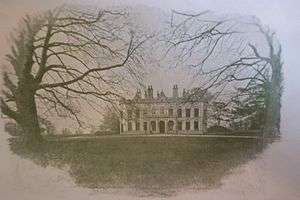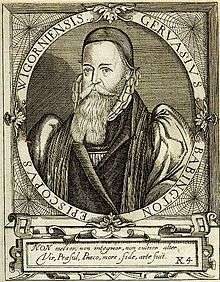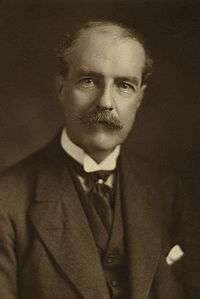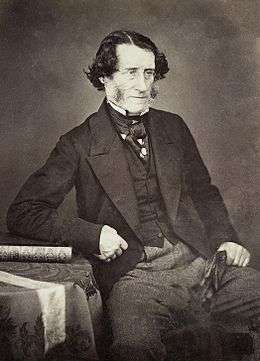Babington family

The Babington family (sometimes Babbington) is an English and Anglo-Irish gentry family descending from Sir John de Babington, lord of the manor of Babington (now Bavington), in Northumberland, who was living in 1178.[1][2][3][4] The family were primarily landowners in Derbyshire (Dethick inheritance), Northumberland, Leicestershire, County Cork, County Donegal and County Londonderry. Family seats included Rothley Court, Dethick Manor, Creevagh House, Roe Park House, Chilwell Hall, Curborough Hall and Packington Hall. The family has routinely produced members who have successively occupied posts such as High Sheriff, Lord Lieutenant and Member of Parliament.[5][2][3][1][6]

History
Sir John de Babington, Lord of Babington, was recorded in the county of Northumberland in 1178. The family had been seated there since the Norman Conquest of 1066.[1] Sir John de Babington (1304-1353), a great-great-grandson of the first recorded Sir John, was Chief Captain of Morlaix in Brittany during the reign of King Edward III, and was buried in monastery of the White Friars at Morlaix.[1] His son, Sir John de Babington (1335-1409) is said to have exclaimed in Norman French: 'foy est tout' ("faith is all"), on being chosen by King Henry IV for dangerous duty in France, which became the family's motto.[7] His son, Thomas Babington of Dethick (died 1464) served with King Henry V at the Battle of Agincourt.[8] Thomas (d. 1464)'s son Sir John Babington of Dethick (1423-1485), was slain at the Battle of Bosworth in 1485 fighting for King Richard III.[9][10][11][6][12] One of Thomas's other sons Sir William Babington (1370-1455) established a branch of the Babingtons at Chilwell and Kiddington.[13]
Thomas Babington of Dethick (d. 13 March 1518), son of Sir John Babington of Dethick and Isabel Bradbourne (1427-1486), and his wife Editha FitzHerbert (d. 1511), daughter of Ralph Fitzherbert, continued the family line at Dethick, as did Thomas's son Sir Anthony Babington (1476-1536). Thomas's fifth son, Humphrey Babington of Rothley Temple started the branch of the family who were seated at Rothley Temple.[14] Brutus Babington, the great-grandson of Sir Anthony Babington was appointed Bishop of Derry by James I and thus started the Anglo-Irish branch of the Babingtons.[15][16][17]
Babingtons of Chilwell and Kiddington
Sir William Babington, Chief Baron of the Exchequer, married Margery Martell and lived at Chilwell Hall. His son, William Babington (1339-1474) was High Sheriff of Nottinghamshire, Derbyshire and the Royal Forests in 1456[18]. William (1339-1474)'s son was Sir John Babington (1425-1501), who fought for Richard III at the Battle of Bosworth alongside his cousin Sir John Babington of Dethick and for Henry VI at the Battle of Stoke Field, and his daughter was Etheldena Babington, who married Sir John Delves and whose daughter Ellen married Sir Robert Sheffield.[19]
Robert Babington (1402-1464), another son of Sir William Babington, married Maulde Venour. His son William Babington (born circa 1442) was Warden of the Fleet Prison and Keeper of the Royal Palace of Westminster, both posts were successively held by this branch of the Babingtons[20].
Philip Babington (1632-1690), the great-great-great-great-great-grandson of William Babington (born circa 1442) was Governor of Berwick-upon-Tweed from 1689-1960 and Member of Parliament for Berwick-upon-Tweed from 1689-1690.[21] William III of England described him as 'a very prudent and honourable man, and assuredly a very brave and excellent officer—even one of the best who have served me here of his nation'.[21]
Babingtons of Dethick
The Babingtons inherited Dethick Manor (through the marriage of Thomas Babington (died 1464) to Isabel Dethick, daughter of Robert Dethick) on Robert's death in 1403. Thomas and Isabel (née Dethick) had two children: Sir John Babington of Dethick (see above) and William Babington, who was President of the Order of Saint Benedict in England. Sir Anthony Babington, Sir John (d. 1485)'s grandson who also held land at Kingston, was Member of Parliament for Nottingham from 1529-1536[22][23]. Sir Anthony's son Thomas (d. 21 April 1560) by his first wife Elizabeth Ormond (d. 28 November 1505) was Justice of the Peace for Derbyshire in 1558 and married Katherine Sacheverell, with whom he had issue including Henry Babington[24] (who married Mary Darcy, daughter of George Darcy, 1st Baron Darcy of Aston, who was mother to Anthony Babington and Maud Babington, who married Christopher Plunkett, 8th Baron of Dunsay, among others). Another son by Sir Anthony's first wife Elizabeth was Bernard, who was father to Rt. Rev Gervase Babington.[24]
Gervase Babington served in the Church of England from 1591-1610, and served as the Bishop of Llandaff (1591–1594), Bishop of Exeter (1594–1597) and Bishop of Worcester from 1597-1610.[25] Bishop Babington was an attendee at the Hampton Court Conference and contributed ideas towards the Lord's Prayer, Ten Commandments and Five Books of Moses.[26]

Anthony Babington (died 1586) was the orchestrator of the so-called "Babington Plot" which aimed to replace the Protestant Queen Elizabeth I with the catholic Mary, Queen of Scots. The plot led to the execution of both Anthony Babington and Queen Mary, together with other conspirators.[27][28]
Following the execution of Anthony Babington in 1586, the lands at Dethick and Kingston passed to his younger brother Francis, who sold much of the land to Gilbert Talbot, 7th Earl of Shrewsbury[29] and died in 1618, passing the remaining lands to his younger brother George, who sold the remaining land.[30]
Babingtons of Rothley Temple
The Babingtons acquired Rothley Temple under Humphrey Babington (1491-1544), who married Eleanor Beaumont and had issue including Thomas Babington of Rothley Temple (1516-1567), who joined in the attempt to place Lady Jane Grey on the throne but ended up paying a fine to Mary I of England, and Francis Babington (d. 1569), who was Vice-Chancellor of Oxford University from 1560 to 1562.[31] and chaplain to the Robert Dudley, 1st Earl of Leicester and was one of his five most trusted advisors in Oxford according to Anthony à Wood.[32]
Thomas Babington of Rothley Temple (1516-1567), aforementioned, married Eleanor Humfrey (1520-1578) and had issue. One of his sons, Zachary Babington (born 1549), served as Archdeacon of Nottingham and is the great-great-grandfather of Zachary Babington (d. 1745), who served as High Sheriff of Staffordshire between 1713-1724.[33] Another son, Humphrey Babington of Rothley Temple (1544-1610), married Margaret Cave (d. 1629) and was the father of Thomas Babington of Rothley Temple (1627-1645) among others, whose son Matthew Babington (1612-1669) was MP for Leicestershire in 1660[34]

Matthew Babington of Rothley Temple (1612-1669) married Anne Hopkins and had four sons and eight daughters, including Thomas Babington of Rothley Temple (1635-1708), who was Member of Parliament for Leicester in 1685 and 1689.[35]. Thomas married Margaret Hall and had several children, notably Frances Babington, who married Sir Joseph Danvers, 1st Baronet[24], and Thomas Babington of Rothley Temple (1682-1745), who married Lydia Cardale on 9 January 1758.[24] Thomas Babington and Lydia Cardale's children included Thomas Babington, a member of the Clapham Sect, who served as Member of Parliament for Leicester from 1800-1818 and was a noted campaigner against slavery[36], Rev. Matthew Babington (1761-1796) who was grandfather to Churchill Babington (the botanist whose publication Mr Macaulay's Character of the Clergy (1849), a defence of the clergy of the 17th Century[37], received the approval of Gladstone[38]), Joseph Babington (1768-1826) who was father of Cardale Babington (the botanist and archaeologist who was a contemporary of Charles Darwin whilst at Cambridge in 1829[39]) and Mary Babington (1760-1841) who married Thomas Gisborne.
Thomas Babington, Member of Parliament for Leicester from 1800 to 1818, married Jean Macaulay, sister of Zachary Macaulay and aunt of Thomas Babington Macaulay.[40] Their eldest son, Thomas Gisborne Babington of Rothley Temple (1788-1871) was also a member of the Clapham Sect and had several children with his two wives, Augusta Julia Noel (daughter of Sir Gerard Noel, 2nd Baronet) and Augusta Felicita Françoise Thérèse Hubertin Vecqueray (daughter of Francis Gerard Vecqueray, one of the Secretaries of State to the King of Prussia for his Grand Duchy of the Rhine), and eventually sold Rothley Temple in 1845 to his brother-in-law Sir James Parker[41], who was married to his sister Mary Babington, whose son Harry Rainy Parker eventually sold Rothley in 1893[42].
Susan Emma Parker (1835-1913), daughter of Sir James Parker and Mary Babington, married Archibald Smith in 1853. One of their sons, Henry (later Sir Henry Babington Smith)[43] changed his surname to Babington Smith and his descendants now use that surname. George Babington Parker, also a child of Sir James Parker and Mary Babington, served as MP for Gladstone in New Zealand from 1871-1875.[44]
Babingtons of Ireland
The Babingtons first settled in Ireland in 1610, when Brutus Babington (1558-1611), the great-grandson of Sir Anthony Babington was appointed Bishop of Derry by James I.[45][16][46]. Brutus was son of Richard Babington (1530-1586), who was the son of Richard Babington (1507-1550) (himself the son of Sir Anthony Babington and Catherine Ferrers) and Margaret Croxton (born 1505), and his wife Anne Starkey (1527-1564), daughter of Richard Starkey (1514-1566) and Jane Legh (1507-1589), whose mother Elizabth Brereton was of the same family as William Brereton, 1st Baron Brereton[47][15]. Brutus Babington married Joan Byrd (1562-1611), daughter of John Byrd and Elizabeth Bine and aunt of John Byrd (c. 1620-1677) (whose grandson was William Byrd II), and had three children. Brutus (d. 1611)'s son Edwin was Sheriff of the city of Londonderry in 1608.[15]
Edwin Babington (born 1585) was taken prisoner during the Irish Rebellion of 1641 and gave evidence to the Commission of Enquiry.[15] He married Francisca Cockes and had a son, Matthew Babington (1610-1689) of Urney and Doe Castle, who was attained by the Dublin Parliament of King James II in 1689.[15] Matthew Babington's children with Elizabeth Galbraith (d. 1635), daughter of Colonel James Galbraith, MP, include Captain William Babington of Urney (1651-1702), who was a Captain in the Derry Garrison during the Siege of Derry in 1689[48] and appears in George Frederick Folingsby's painting 'The Relief of Derry'[49] (also attained by James II's Parliament in 1689), from whom descend the Babingtons of Greenfort, and Captain Richard Babington of Mullagh (1659-1749) who married Isabella Wray, daughter of William Wray (son of Henry Wray and Elizabeth Gore) and Angel Galbraith, and who was a Captain of Dragoons in the Irish Army of William III of England and who fought at the Battle of the Boyne.[15]
William Babington was a grandson of Captain Richard Babington of Mullagh[15] and was a physician and mineralogist whose contributions made him a founder member of the Geological Society of London,[50] where he was president from 1822-1824. Babington was the curator for the mineral collection owned by John Stuart, 3rd Earl of Bute, whose estate sold Babington the collection on his death.[51] The mineral Babingtonite is named after him.[52] Benjamin Guy Babington, William Babington's son, was a physician and epidemiologist, and in 1850 he was elected the founding President of the Epidemiological Society of London.[53] Benjamin Guy Babington's grandchildren included Anna Maria Babington, founder of Babington's tea room in 1893, and Colville Burroughs Babington who emigrated to Argentina in 1889 and who is the grandfather of Carlos Babington.
Lieutenant-General Sir James Melville Babington, son of Lt-Col William Babington (great-great-grandson of Captain Richard Babington of Mullagh[15]), who commanded the 1st Cavalry Brigade as a Major-General during the Second Boer War and commanded the 23rd Division during the First World War [54], was used by The Beatles as the fictional "Sgt. Pepper" for the album "Sgt. Pepper's Lonely Heart's Club Band" in 1967[55].
Charles Hagart Babington (1859-1951), a great-great-grandson of Captain Richard Babington of Mullagh[15] and President of the Institute of Brewing and Distilling in 1904, was the father of Air Marshal Sir John Tremayne Babington and Air Marshal Sir Philip Babington, who were both on the Air Council during the Second World War[56].
20th century politically active members of this branch of the family include Sir Anthony Babington, Member of Parliament for two Belfast constituencies from 1925-1937 and Attorney General for Northern Ireland,[57] and his cousin Robert Babington, Member of Parliament for North Down in the Northern Ireland Parliament from 1969-1972.[58] As well as serving in politics, Robert Babington was a recipient of the Distinguished Service Cross during the Second World War and fought in the Battle of Crete with the Royal Navy.[58]
Rev. Richard Babington, the son of Rev. Richard Babington (1837-1893) and grandson of Rev. Hume Babington (1804-1878), was Dean of Cork from 1914 to 1951.[59]. His son, Ven. Richard Babington, who lived from 1901-1984, was Archdeacon of Exeter from 1958-1970 and Treasurer of Exeter Cathedral from 1962-1970.[60]
Another descendant of the Irish branch of the Babingtons was Anthony Babington, who lived from 1920-2004. He was injured in the Battle of Arnhem and left for dead until slight movements were detected. Babington served in the Dorset Regiment during the Second World War. He was a recipient of the Croix de Guerre. Babington wrote books about the British Army during the Second World War and his ability to overcome his war injuries are documented in his autobiography An Uncertain Voyage.[61]
Babington's tea room

Babington's tea room was founded in 1893 by Isabel Cargill and Anne Marie Babington to establish a traditional English tearoom for the English expats living in Rome. Babington's survived two world wars, the advent of fast food and various economic crises, and has become a favourite meeting place for writers, actors, artists and politicians.[62]
Babingtonite

Babingtonite was named after William Babington (1757–1833). It is the official mineral (mineral emblem) of the Commonwealth of Massachusetts.[63]
Notable members
- Anthony Babington (1561–1586), English nobleman responsible for the Babington Plot against Elizabeth I
- Sir Anthony Babington (1476–1536), MP for Nottingham
- Sir Anthony Babington (1877–1972), Northern Ireland politician, barrister and judge
- Benjamin Guy Babington (1794–1866), English physician and epidemiologist
- Brutus Babington (1558–1611), Bishop of Derry
- Cardale Babington (1808–1895), English botanist and archaeologist
- Churchill Babington (1821–1889), English classical scholar and archaeologist
- Ellen Babington (1877–1956), British Olympic archer in 1908
- Francis Babington (died 1569), English divine and academic administrator
- Gervase Babington (1550–1610), Bishop of Exeter and Worcester
- Sir James Melville Babington (1854–1936), Boer War commander
- Sir John Tremayne Babington (1891–1979), British Air Marshal
- Sir Philip Babington (1894–1965), British Air Marshal
- R. B. Babington (1869-1935), American businessman, telecommunications pioneer, banker, and alderman of Gastonia, North Carolina
- Robert Babington (1920–2010), Northern Ireland politician, barrister and judge
- Thomas Babington (1758–1837), English philanthropist and politician
- William Babington (academic), Vice-Chancellor of Oxford University, 1441–1443
- Sir William Babington (justice) (c. 1370–1454), lawyer and judge
- William Babington (physician) (1756–1833), physician and mineralogist
- Zachary Babington (died 1745), High Sheriff of Staffordshire
- Matthew Babington (1612–1669), MP for Leicestershire in 1660
- Sir Henry Babington Smith (1863–1923), civil servant, whose father Archibald Smith married the daughter of Sir James Parker and Mary Babington
- Constance Babington Smith (1912–2000), journalist and writer
- Michael Babington Smith (1901–1984), prominent banker; a director of the Bank of England
- Anthony Babington Wilson, former business executive and artist
- Sir John Babington of Dethick, knight who died fighting for Richard III at the Battle of Bosworth
- John Babington (mathematician), mathematician and soldier
- Richard Babington (Dean of Cork), Dean of Cork from 1914 to 1951
- Richard Babington (Archdeacon of Exeter), Archdeacon of Exeter from 1958 to 1970
- Philip Babington, Governor of Berwick-upon-Tweed from 1689-1960
- Anthony Babington, Croix de Guerre recipient, author, judge, historian, campaigner
- Carlos Babington, who represented the Argentine national team at the 1974 World Cup.
See also
References
- 1 2 3 4 The Genealogy of the family of Babington of Dethick by G.G.
- 1 2 Burke's Irish Landed Gentry by Bernard Burke, 'Babington of Creevagh', pg 42'
- 1 2 College of Arms pedigree 1966 - Babington
- ↑ 'A history of the Babingtons in Nottinghamshire and Derbyshire in the Fifteenth Century' compiled by Craig Porter
- ↑ "Pedigree of Babington of Dethick". rotherhamweb.co.uk. Retrieved 30 December 2016.
- 1 2 3 Copographica Genealogica, Vol VIII, John Bowyer Nichols and Son. BABINGTONIA.
- ↑ 'The General Armory of England, Scotland, Ireland, and Wales' by Bernard Burke
- ↑ "Dethick - Dethick Village - Peak District Villages - Peak Village - Derbyshire". peakdistrictonline.co.uk. Retrieved 30 December 2016.
- ↑ https://kedlestonderby.files.wordpress.com/2010/11/babingtons.pdf
- ↑ "The Battle of Bosworth Field 1485". tudorplace.com.ar. Retrieved 30 December 2016.
- ↑ 'Discovery Walks in Derbyshire' by Paul A Biggs & Sandra Biggs
- ↑ G.E. Cokayne; with Vicary Gibbs, H.A. Doubleday, Geoffrey H. White, Duncan Warrand and Lord Howard de Walden, editors, The Complete Peerage of England, Scotland, Ireland, Great Britain and the United Kingdom, Extant, Extinct or Dormant, new ed., 13 volumes in 14 (1910-1959; reprint in 6 volumes, Gloucester, U.K.: Alan Sutton Publishing, 2000), volume III, page 154. Hereinafter cited as The Complete Peerage.
- ↑ The Topographer and Genealogist, Volume 1 pg 259 edited by John Gough Nichols.
- ↑ Babington of Rothley
- 1 2 3 4 5 6 7 8 9 Burke's Irish Landed Gentry by Bernard Burke, 'Babington of Creevagh', pg 42'
- 1 2 "Babington, Brutus (BBNN572B)". A Cambridge Alumni Database. University of Cambridge.
- ↑
 Archer, Thomas Andrew (1885). "Babington, Brute". In Stephen, Leslie. Dictionary of National Biography. 02. London: Smith, Elder & Co.
Archer, Thomas Andrew (1885). "Babington, Brute". In Stephen, Leslie. Dictionary of National Biography. 02. London: Smith, Elder & Co. - ↑ The History and Gazetteer of the County of Derby Vol 1 (1831) Stephen Glover. Appendix p 9 Henry VI. Google Books
- ↑ The Gentleman's Magazine, Volume 94, 1803, pg 709
- ↑ Ancient tenures of land, and jocular customs of manors by Thomas Blount
- 1 2 Members Constituencies Parliaments Surveys. "BABINGTON, Philip (c.1632-90), of Berwick-upon-Tweed, Northumb.". History of Parliament Online. Retrieved 2017-03-12.
- ↑ "BABINGTON, Anthony (by 1476-1536), of Dethick, Derbys. and Kingston-on-Soar, Notts. - History of Parliament Online". historyofparliamentonline.org. Retrieved 30 December 2016.
- ↑ Burke's Peerage by Bernard Burke 1999 volume 1, page 228
- 1 2 3 4 Babington of Rothley Temple' in Burke, John, 'A Genealogical and Heraldic History of the Commoners of Great Britain and Ireland'. (London: Henry Colburn, 1838), Vol. IV, p. 513.
- ↑ Gervase Babington, Dictionary of National Biography. http://www.tudorplace.com.ar/Bios/GervaseBabington.htm
- ↑ "Babington, Gervase (BBNN567G)". A Cambridge Alumni Database. University of Cambridge.
- ↑ Office, Public Record. "The National Archives - Exhibitions & Learning online - Exhibitions & Treasures - Secrets & spies". nationalarchives.gov.uk. Retrieved 30 December 2016.
- ↑ "Anthony BABINGTON". tudorplace.com.ar. Retrieved 30 December 2016.
- ↑ Collectanea topographica et genealogica, Volume 8, 'Babingtonia' pg 357, edited by Frederic Madden, Bulkeley Bandinel, John Gough Nichols
- ↑ Collectanea topographica et genealogica, Volume 8, 'Babingtonia' pg 358, edited by Frederic Madden, Bulkeley Bandinel, John Gough Nichols
- ↑ "Previous Vice-Chancellors". University of Oxford, UK. Retrieved 25 July 2011.
- ↑ "Babington, Francis (BBNN544F)". A Cambridge Alumni Database. University of Cambridge.
- ↑ "Townships: Curborough and Elmshurst - British History Online". british-history.ac.uk. Retrieved 30 December 2016.
- ↑ "BABINGTON, Matthew (1612-69), of Rothley Temple, Leics. - History of Parliament Online". historyofparliamentonline.org. Retrieved 30 December 2016.
- ↑ Thomas Babington (1635-1708)
- ↑ "BABINGTON, Thomas (1758-1837), of Rothley Temple, nr. Leicester. - History of Parliament Online". historyofparliamentonline.org. Retrieved 30 December 2016.
- ↑ "Babington, Churchill (BBNN839C)". A Cambridge Alumni Database. University of Cambridge.
- ↑ Obituary of the late Churchill Babington, Suffolk Institute of Archaeology.
- ↑ Darwin Correspondence Project Database. http://www.darwinproject.ac.uk/entry-60/ (letter no. 60; accessed 28 December 2010)
- ↑ "Babington, Thomas (BBNN775T)". A Cambridge Alumni Database. University of Cambridge.
- ↑ "Find your district council | Leicestershire County Council | Rothley - Temple and Chapel of the Knights". leicestershirevillages.com. Retrieved 2017-01-10.
- ↑ http://discovery.nationalarchives.gov.uk/details/r/125a3edc-4fbf-413a-9c2c-7dd966b1407a
- ↑ "Smith, Henry Babington (SMT882HB)". A Cambridge Alumni Database. University of Cambridge.
- ↑ Wilson, James Oakley (1985) [First ed. published 1913]. New Zealand Parliamentary Record, 1840–1984 (4th ed.). Wellington: V.R. Ward, Govt. Printer. p. 225. OCLC 154283103.
- ↑ Burke's Irish Landed Gentry by Bernard Burke, 'Babington of Creevagh', pg 42'
- ↑
 Archer, Thomas Andrew (1885). "Babington, Brute". In Stephen, Leslie. Dictionary of National Biography. 02. London: Smith, Elder & Co.
Archer, Thomas Andrew (1885). "Babington, Brute". In Stephen, Leslie. Dictionary of National Biography. 02. London: Smith, Elder & Co. - ↑ Burke's Irish Family Records 1976, pg 166
- ↑ Ireland Preserved; or the Siege of Londonderry and Battle of Aughrim by Rev John Graham
- ↑ Key plate to the print of "The Relief of Derry."
- ↑ "The Geological Society of London - History". geolsoc.org.uk. Retrieved 30 December 2016.
- ↑ SIR JOHN ST. AUBYN MINERAL AND HERBARIUM COLLECTION. http://www.plymouth.gov.uk/museumstaubyncollection
- ↑ Babingtonite, Hudson Institute of Mineralogy. http://www.mindat.org/min-478.html
- ↑ Evans, A. (2001). "Benjamin Guy Babington: Founding President of the London Epidemiological Society". International Journal of Epidemiology. 30 (2): 226–30. PMID 11369720. doi:10.1093/ije/30.2.226.
- ↑ Baily, Website design by Fiona. "Army Lists - Celebrities of the Army - General J.M. Babington". armylists.org.uk. Retrieved 30 December 2016.
- ↑ http://variety.com/2017/music/news/beatles-real-sgt-pepper-album-cover-1202425909/
- ↑ http://www.iwm.org.uk/collections/item/object/205210286
- ↑ "Lord Justice Babington Note 2 Northern Ireland Legal Quarterly 1938". heinonline.org. Retrieved 30 December 2016.
- ↑ ‘BABINGTON, Ven. Richard’, Who Was Who, A & C Black, an imprint of Bloomsbury Publishing plc, 1920–2016; online edn, Oxford University Press, 2014 ; online edn, April 2014 accessed 11 July 2016
- ↑ "Person Page". thepeerage.com. Retrieved 30 December 2016.
- ↑ "Anthony Babington". independent.co.uk. 22 June 2004. Retrieved 30 December 2016.
- ↑ "Babington's History". babingtons.com. Retrieved 30 December 2016.
- ↑ Massachusetts: Mineral or mineral emblem of commonwealth

.jpg)











